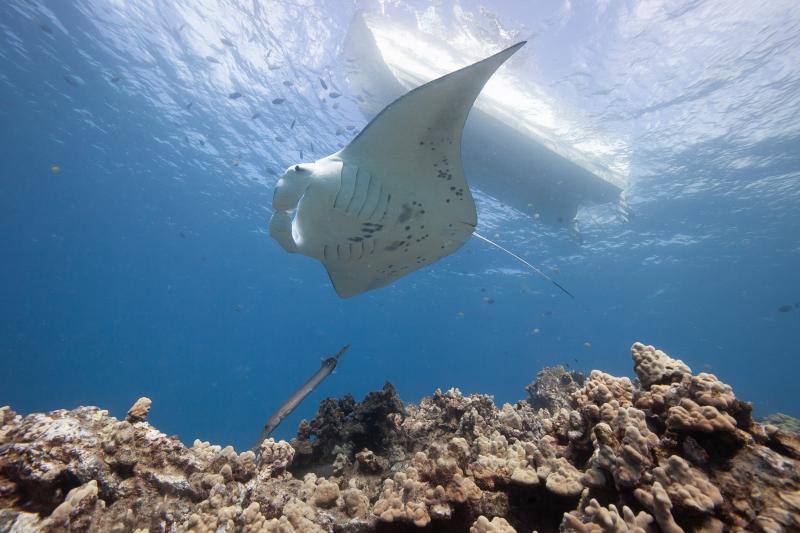
Genetic study finds Reef Manta Rays stay close to home
by NOAA Fisheries 22 Jul 2023 18:48 UTC

Reef manta ray visiting a reef in South Maui, Hawaii © Hawaii Association for Marine Education and Research/Mark Deakos
New research shows that manta rays in Hawai'i live in isolated, island-specific, and genetically distinct populations. A team of researchers from NOAA's Pacific Islands Fisheries Science Center, the Hawai‘i Association for Marine Education and Research, and the University of Miami conducted the first genetic study of reef manta rays in Hawai'i.
The results were published in BMC Ecology and Evolution. The researchers used genome scans to investigate population differences between reef manta rays of Hawai'i Island and Maui Nui (the four-island complex of Maui, Moloka'i, Lana'i, and Kaho'olawe). Their work reveals that Hawai'i Island and Maui Nui populations are made up of only a few hundred individuals each and should be considered distinct and separate. Small and isolated animal populations are vulnerable to disease and extinction. Each island may need separate management strategies to ensure the rays' long-term stability.
Mantas Stay Close to Home
Reef manta rays are strong swimmers and could easily travel the tens of miles to different islands. However, this study found that these reef manta rays stay close to home and rarely cross the deep channels between islands. Researchers compared differences in the genes inherited by both parents and those inherited only from mothers to better understand migration differences between males and females. They found that females only reproduce at the island where they were born. Migration rates are equivalent to one female moving between island groups every 1,300 years and one male only about every 64 years.
"We offer the first direct evidence that female reef manta rays reproduce close to their birthplace, which leads to strong genetic isolation of populations," said Dr. Jonathan Whitney, an ecologist at NOAA's Pacific Islands Fisheries Science Center and lead author of the study. "Ultimately, this means that each island population is demographically on its own. So if the manta population in West Hawai'i declines, they are unlikely to be repopulated by the neighboring islands."
Small Communities
The genetic evidence from this study confirms findings from photo identification and tagging research. These estimates correspond well with the photo catalog of unique ventral markings for both of these populations. They have identified only 318 unique individuals around Hawai'i Island since 1979, and around 600 unique individuals in Maui Nui since 2005. To date, no photo-ID has been matched between the two populations confirming that they do not mix.
Using genome scans, researchers estimated the number of adult breeders in each population. Out of the total population, there were only about 104 adult breeders on Hawai'i Island and 129 throughout Maui Nui.
"These are already small populations and even a smaller proportion are actually breeding," said Dr. Richard Coleman, an Assistant Professor from the University of Miami and coauthor of the study. "With so few breeders, the loss of a single individual could have long term detrimental consequences to the resilience of Hawai'i reef manta rays."
"Based on the photo-ID and movement tracking data, we anticipated very little interchange between Hawai'i Island and Maui Nui. We never expected it would be as infrequent as one male every few generations and females almost never leaving their birth island," said Dr. Mark Deakos, coauthor and Director of the Hawai'i Association for Marine Education and Research.
Vulnerable Populations
Small population size and low reproductive rates make these isolated populations extremely vulnerable to human impact. Reef mantas face several threats:
- Fishing line entanglement: One in 10 manta rays show evidence of having been entangled in fishing line with amputated fins and wings, lacerations, and fishing hooks still embedded in their bodies
- Boat strikes: Manta rays aggregate close to the surface where they can be struck by boats and injured by propellers
- Habitat loss: Coastal development can degrade coral reefs and embayments which are critical habitat for manta cleaning, socializing, breeding, and pupping
Additionally, manta rays grow slowly, mature late, and have few pups. Mature females produce only a single pup every 1 to 7 years. If populations decline, these traits can hinder their potential recovery.
"We are fortunate that manta rays in Hawai'i are protected against being captured or killed, but they are still vulnerable to human-made threats," noted Dr. Deakos. "These results highlight the vulnerability of these populations and stress the need to ensure we safeguard these precious ocean giants for future generations."
Maintaining Manta Momentum
This study focused on reef manta rays in known gathering sites in Hawai'i and Maui, but a more comprehensive statewide survey is under way. To protect and preserve the small, slow-growing, island-specific populations of Hawai'i, researchers plan to continue monitoring and gathering information. The team is working with partners across the state to expand the study and find aggregation areas on other islands. The work will help us understand gene flow and population size across all Hawaiian Islands.
Community members can report sightings of manta rays on any island to the Hawai'i Association for Marine Education and Research and the Manta Pacific Research Foundation.